What is smart glass technology and how does it work?
In fact, smart glasses consist of two layers of glass together with a smart film that gets its ability to become opaque and transparent from this film. To learn about smart glass technology and how smart films work, we need to learn more about its structure.
The smart film consists of several layers of advanced materials that are placed next to each other with high technology, each of which plays a role. The upper layers of this film are made of PET polymer sheets, which are covered with a very thin layer of a transparent material that conducts electricity. Between two layers of these polymer sheets, a material called PDLC is placed. The constituents of this layer are actually liquid crystals that are dispersed in a completely irregular manner in a polymer field.
This irregular distribution causes the light rays to break and make the film opaque. Now, if an electric current is passed through the two layers of electricity conductors, an electric field is formed, which causes the irregular crystals to be completely regular and aligned. This alignment enables the passage of light rays without breaking and directly. In this way, the smart glass is transparent.
Smart films can be placed between two layers of glass or glued on the installed glass with a self-adhesive back. In the first case, the smart film is laminated between two layers of glass under special conditions. In this case, you can use glass with different thicknesses and colors to produce opaque smart glass. Smart glass technology is very sensitive and it is possible to be damaged by impact, humidity, dust and scratches. Therefore, smart taluks with adhesive back will need more care and maintenance.
Nowadays, the use of smart glass technology, due to its unique capabilities, has been noticed in hotels, medical centers, office buildings to create office partitions and residential use such as apartments or luxury villas.
Smart glass technology
Smart glass refers to a group of glasses whose optical properties change due to various parameters such as electric current, heat and light. The structure of smart glass is divided into two categories: controllable (Active) and passive (Passive).
In passive smart glass, the state does not change due to electric current. The two main categories of this product are photochromic and thermochromic glasses. As it is clear from their name, photochromic glasses change color due to the change of light intensity, while thermochromic glasses change color due to the increase of heat, and the higher the light intensity, the darker the glass will be.
In smart glass that can be controlled (Active), the change of state is caused by the establishment of an external current. As a result, the user can control the transparency of the glass by switching on and off the electric current. Smart glass is divided into three main categories: PDLC, SPD and .EC
In PDLC smart glasses, it is possible to control the amount of transparency in a fraction of a second (40 milliseconds), and it is also possible to create complete privacy in this model, which has led to an increasing use of this product. In SPD glasses, it takes time to change the mode (1 to 3 seconds) and it is not possible to create complete privacy. Also, due to the blue color of these glasses, its use is limited only for the facade of the building.
In electrochromic (EC) glasses, the glass changes its state due to the DC electric current, and this model is generally not applicable due to the time-consuming process of changing the state and the darkening of the glass when the electricity current is established and the space darkens. It is limited like airplane windows and car mirrors.
Due to the wide applications of smart glass technology, extensive research is being done to increase the quality and efficiency of this product.

